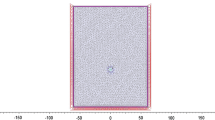Abstract
Although deformation along a weak joint under a strong seismic event can seriously damage the tunnel, the effect of joint has not yet been well understood or quantified. We perform a series of pseudo-static discrete element analyses to evaluate the effect of deformation along rock joint on the seismic response of circular tunnels. We also perform parallel continuum analyses to compare and quantify their differences. A comprehensive set of joint parameters are considered in this study. The results illustrate that the joint significantly increases the moment demand in the tunnel lining, whereas it has a secondary influence on the thrust. The joint stiffness and shear strength have critical influence on the tunnel response. Widely spaced joint set produces a larger tunnel response. The tunnel response is highest for vertical and horizontal joints, and the lowest when the joint dips at an angle of 45°. The moment in jointed rock may be 20 times higher than that in intact rock. The pronounced deviation from continuum analyses highlights the need to estimate the influence of discontinuities on the seismic response of underground tunnels from discrete element analyses. This may be of concern for critical structures such as nuclear facilities.
Similar content being viewed by others
References
Ahn, J. K., Park, D. H., Kim, D. K., and Kim, K. Y. (2013). “Evaluation of seismic performance of road tunnels in operation.” Journal of Korean Tunnelling and Underground Space Association, Vol. 15, No. 2, pp.69–80.
Argyroudis, S. and Pitilakis, K. (2012), “Seismic fragility curves of shallow tunnels in alluvial deposits.” Soil Dynamics and Earthquake Engineering, Vol. 35, pp. 1–12.
Asakura, T. and Sato, Y. (1996). “Damage to mountain tunnels in hazard area.” Soils and foundations, pp. 301–310.
Bandis, S., Lumsden, A., and Barton, N. (1983). “Fundamentals of rock joint deformation.” Elsevier, Vol. 20, pp. 249–268.
Barton, N. (1995). The influence of joint properties in modelling jointed rock masses, 8th ISRM congress: International Society for Rock Mechanics.
Barton, N. R. (1976). “The shear strength of rock and rock joints.” International Journal of Rock Mechanics and Mining Sciences, Vol. 13, No. 9, pp. 255–279.
Bhasin, R. and Høeg, K. (1998). “Parametric study for a large cavern in jointed rock using a distinct element model (UDEC—BB).” International Journal of Rock Mechanics and Mining Sciences, Vol. 35, No. 1, pp.17–29.
Boulanger, R. and Ziotopoulou, K. (2012). PM4Sand (Version 2): a sand plasticity model for earthquake engineering applications, University of California at Davis, California.
Cilingir, U. and Gopal Madabhushi, S. (2011). “A model study on the effects of input motion on the seismic behaviour of tunnels.” Soil Dynamics and Earthquake Engineering, Vol. 31, No. 3, pp. 452–462.
Hao, H., Wu, Y., Ma, G., and Zhou, Y. (2001). “Characteristics of surface ground motions induced by blasts in jointed rock mass.” Soil Dynamics and Earthquake Engineering, Vol. 21, No. 2, pp. 85–98.
Hao, Y. and Azzam, R. (2005). “The plastic zones and displacements around underground openings in rock masses containing a fault.” Tunnelling and Underground Space Technology, Vol. 20, No. 1, pp. 49–61.
Hashash, Y. M. A, Karina, K., Koutsoftas, D., and O'Riordan, N. (2010). “Seismic design considerations for underground box structures.” Earth Retention Conference, Vol. 3, pp. 1–4.
Hashash, Y. M. A. (2002). Seismic design of underground structures: Role of numerical modeling, North American Tunneling.
Hashash, Y. M. A. and Park, D. (2001). “Non-linear one-dimensional seismic ground motion propagation in the Mississippi embayment.” Engineering Geology, Vol. 62, Nos. 1-3, pp. 185–206.
Hashash, Y. M. A., Marulanda, C., Ghaboussi, J., and Jung, S. (2003). “Systematic update of a deep excavation model using field performance data.” Computers and Geotechnics, Vol. 30, pp. 477–488.
Itasca Consulting Group, I. (2002). Manual, FLAC, Itasca Consulting Group, Inc.
Itasca Consulting Group, I. (2004). UDEC Universal Distinct Element Code, User's Manual, Itasca Consulting Group, Inc.
Kulhawy, F. H. (1975). “Stress deformation properties of rock and rock discontinuities.” Engineering Geology, Vol. 9, No. 4, pp. 327–350.
Li, J. and Ma, G. (2010). “Analysis of blast wave interaction with a rock joint.” Rock Mechanics and Rock Engineering, Vol. 43, No. 6, pp. 777–787.
Ma, M. and Brady, B. (1999). “Analysis of the dynamic performance of an underground excavation in jointed rock under repeated seismic loading.” Geotechnical & Geological Engineering, Vol. 17, No. 1, pp. 1–20.
MOCT (2010). The Revision of the Road-Design Guideline (The Chapter of Tunnel), Ministry of Constructio and Transportation.
Penzien, J. and Wu, C. L. (1998). “Stresses in linings of bored tunnels.” International Journal of Earthquake Engineering and Structural Dynamics, Vol. 27, pp. 283–300.
Schnabel, P. B., Lysmer, J. L., and Seed, H. B. (1972). SHAKE: A computer program for earthquake response analysis of horizontally layered sites, EERC-72/12, Earthquake Engineering Research Center, Berkeley, CA.
Sedarat, H., Kozak, A., Hashash, Y., Shamsabadi, A., and Krimotat, A. (2009). “Contact interface in seismic analysis of circular tunnels.” Tunnelling and Underground Space Technology, Vol. 24, No. 4, pp. 482–490.
Seed, H. B. and Idriss, I. M. (1970). Soil moduli and damping factors for dynamic response analyses, University of California, Berkeley, Berkeley.
Vanmarcke, E. H., Fenton, G. A., and Heredia-Zavoni, E. (1999). SIMQKEII, Conditioned earthquake ground motion simulator: User's manual, version 2.1 Princeton University, Princeton.
Vardakos, S. S., Gutierrez, M. S., and Barton, N. R. (2007). “Backanalysis of Shimizu Tunnel No. 3 by distinct element modeling.” Tunnelling and Underground Space Technology, Vol. 22, No. 4, pp. 401–413.
Wang, J. (1993). “Seismic design of tunnels: A state-of-the-art approach, Parsons Brinckerhoff Quade & Douglas.” Inc., New York, NY, Monograph 7.
Author information
Authors and Affiliations
Corresponding author
Rights and permissions
About this article
Cite this article
Yoo, JK., Park, JS., Park, D. et al. Seismic Response of Circular Tunnels in Jointed Rock. KSCE J Civ Eng 22, 1121–1129 (2018). https://doi.org/10.1007/s12205-017-1184-7
Received:
Revised:
Accepted:
Published:
Issue Date:
DOI: https://doi.org/10.1007/s12205-017-1184-7




